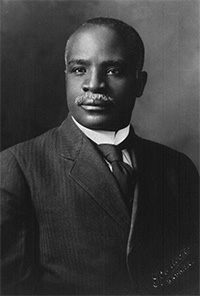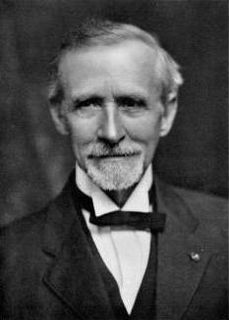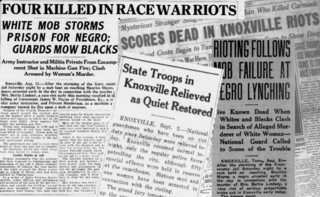Related Research Articles

William Gannaway "Parson" Brownlow was an American newspaper publisher, Methodist minister, book author, prisoner of war, lecturer, and politician. He served as the 17th Governor of Tennessee from 1865 to 1869 and as a United States Senator from Tennessee from 1869 to 1875. Brownlow rose to prominence in the late 1830s and early 1840s as editor of the Whig, a polemical newspaper in East Tennessee that promoted Whig Party ideals and opposed secession in the years leading up to the American Civil War. Brownlow's uncompromising and radical viewpoints made him one of the most divisive figures in Tennessee political history and one of the most controversial Reconstruction Era politicians of the United States.

Knoxville College is a historically black liberal arts college in Knoxville, Tennessee, United States, which was founded in 1875 by the United Presbyterian Church of North America. It is a United Negro College Fund member school.

Kelly Miller was an American mathematician, sociologist, essayist, newspaper columnist, author, and an important figure in the intellectual life of black America for close to half a century. He was known as "the Bard of the Potomac".
Nashville, Tennessee is the 30th largest media market in the United States with roughly 966,000 homes, 0.8% of the country's media market.{cn|date=April 2022}}

The Knoxville News Sentinel is a daily newspaper in Knoxville, Tennessee, United States, owned by the Gannett Company.

William Henry Hastie Jr. was an American lawyer, judge, educator, public official, and civil rights advocate. He was the first African American to serve as Governor of the United States Virgin Islands, as a federal judge, and as a federal appellate judge. He served as a United States Circuit Judge of the United States Court of Appeals for the Third Circuit and previously served as District Judge of the District Court of the Virgin Islands.
The East Tennessee Historical Society (ETHS), headquartered in Knoxville, Tennessee, United States, is a non-profit organization dedicated to the study of East Tennessee history, the preservation of historically significant artifacts, and educating the citizens of Tennessee. The society operates a museum and museum shop in the East Tennessee History Center on Gay Street in downtown Knoxville. The East Tennessee Historical Society was established in 1834, 38 years after the establishment of the state of Tennessee, to record the history of the development and settlement of the area.

John Wesley Edward Bowen was born into American slavery and became a Methodist clergyman, denominational official, college and university educator and one of the first African Americans to earn a Ph.D. degree in the United States. He is credited as the first African American to receive the Ph.D. degree from Boston University, which was granted in 1887.

William Rule was an American newspaper editor and politician, best known as the founder of The Knoxville Journal, which was published in Knoxville, Tennessee, from 1870 until 1991. A protégé of vitriolic newspaper editor William G. "Parson" Brownlow, Rule established the Journal as a successor to Brownlow's Knoxville Whig. Rule twice served as mayor of Knoxville, and published the city's first comprehensive history, Standard History of Knoxville, in 1900.

The Knoxville riot of 1919 was a race riot that took place in the American city of Knoxville, Tennessee, on August 30–31, 1919. The riot began when a lynch mob stormed the county jail in search of Maurice Mays, a biracial man who had been accused of murdering a white woman. Unable to find Mays, the rioters looted the jail and fought a pitched gun battle with the residents of a predominantly black neighborhood. The Tennessee National Guard, which at one point fired two machine guns indiscriminately into this neighborhood, eventually dispersed the rioters. At the end of August 1919 the Great Falls Daily Tribune reported four killed in a "race war riot" while the Washington Times reported "Scores dead." Other newspapers placed the death toll at just two, though eyewitness accounts suggest it was much higher.

William Francis Yardley was an American attorney, politician and civil rights advocate, operating primarily out of Knoxville, Tennessee, in the late 19th century. He was Tennessee's first African-American gubernatorial candidate, and is believed to have been the first African-American attorney to argue a case before the Tennessee Supreme Court. He published a newspaper, the Examiner, that promoted African-American rights, and was an advocate for labor and the poor both as an attorney and as a politician.
Charles Warner Cansler was an American educator, civil rights advocate, and author, active primarily in Knoxville, Tennessee, USA. A grandson of William Scott, a pioneering Black American publisher, and the son of Knoxville's first Black American teacher, Cansler was instrumental in establishing educational opportunities for Knoxville's Black American children in the late 19th and early 20th centuries. His 1940 biography, Three Generations: The Story of a Colored Family in Eastern Tennessee, remains an important account of black life in 19th century East Tennessee.
Virginia E. (Walker) Broughton was an African-American author and Baptist missionary. One of four students in the first class at Fisk College in 1867, she later became a recognized religious scholar, writing articles for the National Baptist Union newspaper and National Baptist Magazine. As a prominent member of the Baptist church and National Corresponding Secretary of the National Baptist Convention, she worked to ensure that the issues of African-American religious women were addressed by the governing body of the denomination. Broughton was licensed as a missionary and subsequently commissioned to the mission field. Her teaching, writing and preaching were popular among women and men alike.
The following is a timeline of the history of the city of Memphis, Tennessee, US.
The following is a timeline of the history of the city of Knoxville, Knox County, Tennessee, USA.
African Americans are among the largest ethnic groups in the state of Tennessee, making up 17% of the state's population in 2010. African Americans arrived in the region prior to statehood. They lived both as slaves and as free citizens with restricted rights up to the Civil War. The state, and particularly the major cities of Memphis and Nashville have played important roles in African-American culture and the Civil Rights Movement. The majority of African Americans in Tennessee reside in the western part of the state, with much smaller Black populations in the central and eastern (Appalachian) regions of the state.
The Tennessee Tribune is an African-American newspaper in Nashville, Tennessee. Its circulation is statewide - Nashville, Chattanooga, Knoxville and Memphis, Tennessee. It was founded in 1991 by Rosetta Irvin Miller-Perry.

Irvine Garland Penn was an educator, journalist, and lay leader in the Methodist Episcopal church in the United States. He was the author of The Afro-American Press and Its Editors, published in 1891, and a coauthor with Frederick Douglass, Ida B. Wells, and Ferdinand Lee Barnett of The Reason Why the Colored American Is Not in the World's Columbia Exposition in 1893. In the late 1890s, he became an officer in the Methodist Episcopal Church and played an important role advocating for the interests of African Americans in the church until his death.
References
- ↑ "History, Philosophy and Newspaper Library Newspaper Database". www.library.illinois.edu.
- ↑ "The Knoxville Negro World (Knoxville, Tenn.) 1887-1888". Library of Congress.
- ↑ Gore, George W. (June 26, 1922). "Negro Journalism: An Essay on the History and Present Conditions of the Negro Press" – via Google Books.